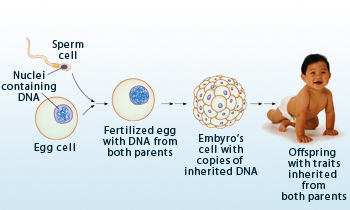 Development of an organism
A zygote initially develops into a hollow sphere, called a blastula, which undergoes rearrangement and differentiation. In sponges, blastula larvae swim to a new location and develop into a new sponge. In most other groups, the blastula undergoes more complicated rearrangement. It first invaginates to form a gastrula with a digestive chamber, and two separate germ layers– an external ectoderm and an internal endoderm. In most cases, a mesoderm also develops between them. These germ layers then differentiate to form tissues and organs.
Development of an organism
A zygote initially develops into a hollow sphere, called a blastula, which undergoes rearrangement and differentiation. In sponges, blastula larvae swim to a new location and develop into a new sponge. In most other groups, the blastula undergoes more complicated rearrangement. It first invaginates to form a gastrula with a digestive chamber, and two separate germ layers– an external ectoderm and an internal endoderm. In most cases, a mesoderm also develops between them. These germ layers then differentiate to form tissues and organs.
The bodies of most animals (all except sponges) are made up of cells organized into tissues, each tissue specialized to some degree to perform specific functions. Animals have other unique types of intercellular junctions, including tight junctions, desmosomes, and gap junctions, which hold tissues together. These junctions are also composed of structural proteins.
Animals have muscle tissue and nervous tissue. These tissues can range from being indistinct to being highly complex. Most animals reproduce sexually, with the diploid stage usually dominating the life cycle. In most species, a small flagellated sperm fertilizes a larger, non-motile egg. The zygote undergoes cleavage, a succession of mitotic cell divisions, leading to the formation of a multicellular, hollow ball of cells called the blastula. During gastrulation, part of the embryo folds inward, forming layers of embryonic tissues that will develop into adult body parts. The resulting development stage is called a gastrula.
Some animals develop directly through transient stages into adults, but others have a distinct larval stage or stages. A larva is a sexually immature stage that is morphologically distinct from the adult, usually eats different foods, and may live in a different habitat from the adult. Animal larvae eventually undergo metamorphosis, transforming the animal into an adult.
Animals share a unique homeobox-containing (A homeobox is a DNA sequence found within genes that are involved in the regulation of patterns of anatomical development (morphogenesis) in animals, fungi and plants) family of genes known as Hox genes. All eukaryotes have genes that regulate the expression of other genes. Many of these regulatory genes contain common modules of DNA sequences called homeoboxes. All animals share the unique family of Hox genes, suggesting that this gene family arose in the eukaryotic lineage that gave rise to animals. Hox genes play important roles in the development of animal embryos, regulating the expression of dozens or hundreds of other genes. Hox genes control cell division and differentiation, producing different morphological features of animals.